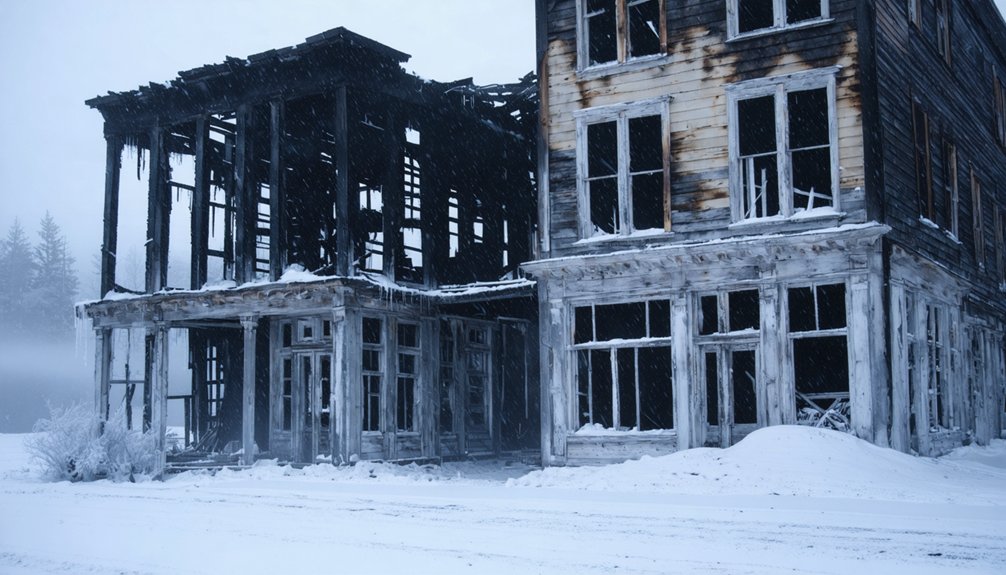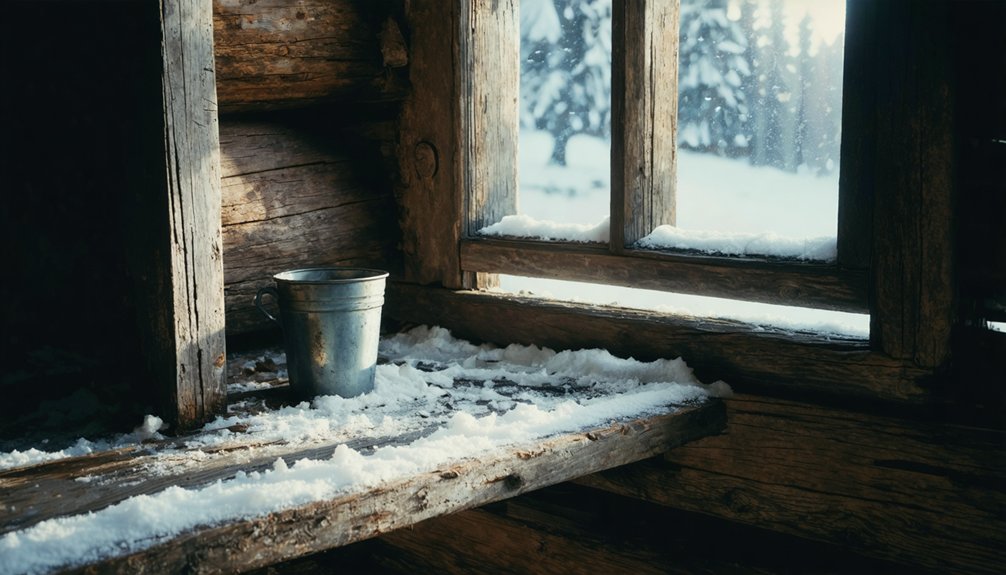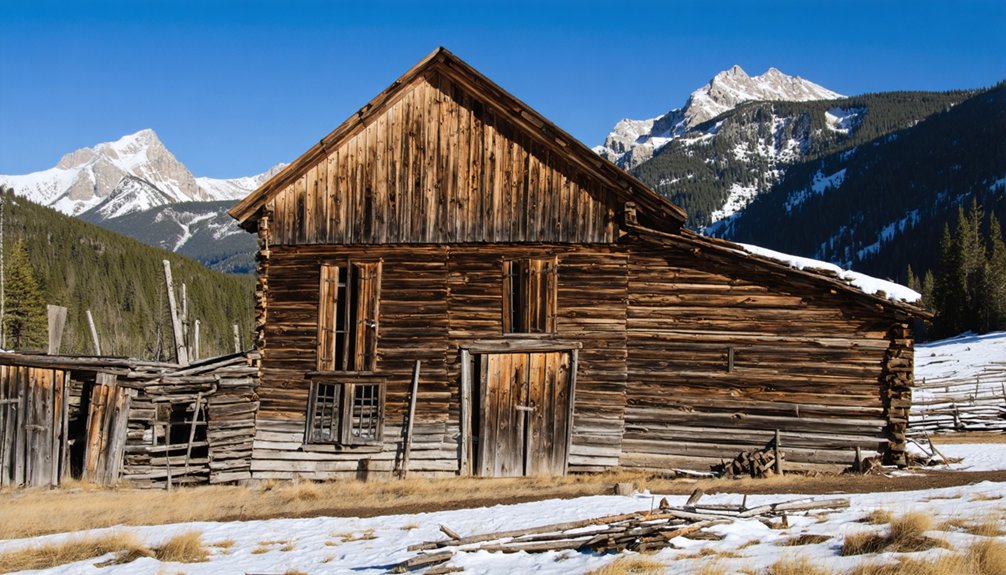You’ll find Caribou’s remains on a windswept mountain at 10,000 feet, where Colorado’s first major silver strike occurred in 1869. Initially prosperous with 3,000 residents, the town boasted churches, schools, and saloons before declining after the 1893 Silver Crash. A devastating 1905 fire delivered the final blow. Today, only two stone buildings and scattered mining equipment mark this once-thriving settlement. The ghost town‘s weathered ruins tell a compelling story of boom-and-bust resilience.
Key Takeaways
- Caribou was Colorado’s first major silver discovery in 1869, growing from tents to a 3,000-resident town by 1875.
- The town produced approximately $6 million in silver during its peak years before declining in the late 19th century.
- A devastating fire in 1905 delivered the final blow to Caribou after the 1893 Silver Crash had already accelerated abandonment.
- Today, only two stone buildings, a collapsed wooden cabin, and scattered mining remnants survive among nature-reclaimed foundations.
- Visitors can access the ghost town via Caribou Road from Nederland, though weather conditions may limit accessibility.
The Discovery of Silver and Birth of a Mining Camp
In August 1869, when the Colorado Territory was still developing its mining potential, William Martin and George Lytle made a discovery that would transform the region. Following a lead from Samuel Conger, who’d found silver ore fragments while hunting, these experienced miners tracked the silver-bearing rocks up a creek to rich veins at over 10,000 feet elevation.
Their mining partnership began after Conger recognized similarities between his samples and the famous Comstock Lode. Martin and Lytle named their claims the Caribou and Poor Man veins, establishing what would become Colorado’s first major silver discovery.
They endured winter in tents to protect their claims, filing formal paperwork in December 1869. By spring 1870, word had spread, bringing dozens of prospectors to the high-altitude site. The settlement quickly grew into a thriving mining town with a peak population of approximately 3,000 residents by the mid-1870s.
From Tents to Town: Caribou’s Rapid Growth
Community building accelerated dramatically as silver production took off.
By 1875, Caribou transformed from a cluster of tents and brush houses to a thriving town of 3,000 residents with infrastructure including a church, three saloons, and a brewery.
Frontier tents gave way to a vibrant community as Caribou bloomed with churches, saloons, and 3,000 eager residents.
This growth paralleled the economic success of the mines, which produced approximately $6 million in silver.
Despite its prosperity, the town maintained a remarkably peaceful and law-abiding atmosphere, with gambling and brothels strictly prohibited within its boundaries.
The development of the sophisticated Caribou Mill further solidified the camp’s evolution from temporary outpost to established mining community.
The town also featured the Caribou Post newspaper which served as a vital information source for the bustling mining community.
Life in a Rocky Mountain Boomtown
If you’d visited Caribou during the 1870s silver rush, you would’ve encountered miners contending with some of the harshest winter conditions in Colorado, where snowdrifts often reached second-story windows and temperatures plummeted to dangerous lows.
Daily life centered around the town’s saloons and gambling halls, which served as community gathering places where miners sought respite from backbreaking labor in the silver mines. The discovery of valuable minerals in the area had transformed Caribou from wilderness into a bustling settlement virtually overnight. The arrival of the railroad was marked with grand celebrations, similar to those seen in other Colorado mining towns like Aspen and Glenwood Springs.
Despite the mainly male population, families gradually established themselves, bringing a semblance of stability through the development of schools, merchants, and social customs that mirrored traditional Old West values of self-reliance and perseverance.
Harsh Weather, Hardy People
While modern Americans might struggle to imagine life at 8,200 feet elevation, Caribou’s hardy residents endured extreme conditions that shaped every aspect of their daily existence.
Temperatures plummeting to -35°F, blizzards with 40 mph winds, and snowpacks several feet deep defined their winter reality.
Weather resilience emerged through practical adaptations—insulated log cabins, wood-burning stoves, and food preservation in root cellars sustained families through isolation. The unpredictable mountain weather created challenges similar to those faced by visitors in Rocky Mountain National Park, where strong winds can make outdoor activities treacherous and require careful preparation.
When mining operations halted and transportation ceased, community spirit flourished. Neighbors cooperated for survival, sharing the burden of snow removal and firewood gathering.
Social gatherings in churches and schools provided both physical warmth and emotional support during confinement.
This mutual aid system, born of necessity, fostered the self-reliance that became Caribou’s defining characteristic as residents faced nature’s harshest challenges together.
Silver Rush Daily Life
Once silver veins were discovered in 1869, Caribou rapidly transformed from untamed wilderness into Colorado’s first major silver camp, attracting thousands of hopeful miners and entrepreneurs.
By 1875, nearly 3,000 residents called this mountain settlement home.
Daily life revolved around the mines, where partnerships like Martin and Lytle exemplified the cooperative spirit needed for success.
You’d start your day in a simple log cabin—a significant upgrade from the tents that dotted the landscape in the earliest days.
After grueling shifts separating rich silver ore from worthless rock, you might join community gatherings at one of three saloons or attend church functions. Historical records indicate the actual population was more modest at 500 to 800 residents during the boom years, contrary to exaggerated claims.
The *Caribou Post* newspaper kept everyone informed while serving as social glue.
Despite harsh conditions at 10,000 feet elevation, the town maintained a convivial atmosphere where residents faced challenges together, much like the stone-built trapping systems ancient humans used to hunt wild reindeer in Norway.
The Switzerland Trail: Lifeline to Civilization
You’ll discover the Switzerland Trail was Caribou’s crucial connection to the outside world, initially established in 1883 by the Greeley, Salt Lake & Pacific railroad and later rebuilt following the devastating 1894 flood.
The picturesque mountain route, renamed by Colorado & Northwestern in 1898 to attract tourists, wound through spectacular alpine scenery at elevations between 7,000-9,000 feet while transporting essential ore, equipment, and passengers. The trail was particularly important for transporting ore from the Blue Bird Mine and other historically significant mining operations in the region. The railroad never fully paid for itself, facing economic viability challenges throughout its operation.
The line’s eventual abandonment in 1919 by the Denver, Boulder & Western railroad marked the beginning of Caribou’s decline, with tracks removed and the grade later repurposed as recreational trails through Boulder County’s open space.
Construction and Engineering
The Switzerland Trail, a remarkable feat of late 19th-century engineering, transformed Colorado’s mining landscape through its innovative narrow-gauge railroad design. The 3-foot gauge tracks stretched approximately 30 miles through elevations ranging from 7,000 to over 9,000 feet, connecting essential mining communities like Caribou, Ward, and Eldora.
You can appreciate the immense railroad engineering challenges overcome by builders who tackled rugged mountainous terrain with steep grades and tight curves.
Construction required extensive bridging and trestling across valleys, canyons, and creeks throughout Boulder County. Engineers masterfully adapted rail alignments to minimize costs while maintaining connections to multiple mining operations.
The narrow-gauge approach enabled sharper curves and lighter infrastructure—perfectly suited for Colorado’s difficult topography. Today’s hiking trails following these trackbeds reveal how engineers ingeniously integrated the railroad with the natural landscape.
Tourism and Scenery
Named in 1898 by the Colorado & Northwestern Railroad to evoke Switzerland’s legendary beauty, the Switzerland Trail quickly transcended its utilitarian origins to become a celebrated tourist destination while maintaining its critical function as a lifeline for isolated mining communities.
Today, you’ll experience spectacular scenic views along this serpentine route winding through altitudes between 7,000 and 9,000 feet. As you traverse the intact railroad roadbed, you’ll encounter aspen groves, summer wildflowers, and opportunities to spot elk.
The trail’s connection to Caribou—once home to 3,000 residents during Colorado’s first silver rush—makes it a premier ghost town tourism destination.
The Switzerland Trail perfectly blends natural splendor with mining heritage, offering panoramic vistas of the Front Range while passing historic ruins and abandoned mines that tell the story of Colorado’s boom-and-bust past.
Abandonment and Decay
As Colorado’s silver boom began to wane in the late 19th century, the Switzerland Trail railroad—once a vital artery connecting isolated mining communities to civilization—faced mounting financial pressures that would ultimately seal its fate.
The devastating 1894 flood destroyed significant sections of track, bankrupting the GSL&P Railroad and setting in motion a cycle of rebuilding and eventual decline.
The railroad’s closure in 1919 had a profound impact on Caribou and surrounding communities.
Transportation costs skyrocketed as mines reverted to wagon transport, accelerating their economic collapse. Community isolation intensified as mountain towns lost their connection to Boulder and Denver.
Today, you’ll find only the ghostly remains of this once-vital network—eroded roadbeds, collapsing trestles, and scattered ruins—silent testimonies to civilization’s retreat from these mountain heights.
Mining Challenges at 10,000 Feet
Perched at an elevation exceeding 10,000 feet, Caribou confronted miners with extraordinary challenges rarely encountered in lower-altitude operations. You’d find specialized mining techniques necessary to extract silver from veins that formed rich ore shoots at intersections of east-west and northeast-southwest veins.
Environmental adaptations were essential for survival and productivity. Workers constructed snow sheds—corrugated metal tunnels—to maintain year-round access despite heavy snowfall and avalanche risks.
You’d notice ore being transported 2,000 feet downhill to Nederland for processing, as the altitude demanded significant infrastructure modifications.
The richest silver deposits occurred within the upper 300 feet, where surface weathering concentrated valuable minerals above the water table. Miners hand-sorted high-grade ore in sorting sheds, while contending with afternoon thunderstorms in summer and extreme cold in winter.
The Silver Crash and Economic Fallout

The Silver Crash of 1893 struck Caribou with devastating force, accelerating the town’s already-begun decline as silver prices plummeted nationwide.
You’d witness international repercussions as Dutch and New York investors suffered massive financial losses, including R.G. Dun who died with significant debts tied to the mines.
Residents abandoned Caribou in waves following the crash, leaving businesses shuttered and homes empty years before the catastrophic 1905 fire delivered the final blow to this once-thriving mining community.
Silver’s Devastating Collapse
While Caribou thrived as one of Colorado’s premier silver camps throughout the 1870s, signs of vulnerability appeared well before the devastating crash of 1893.
You’d have noticed declining ore quality, persistent flooding in mines, and increasing operational costs undermining profitability despite substantial mining investments from financiers like R.G. Dun.
When Congress repealed the Sherman Silver Purchase Act in 1893, silver prices plummeted nationwide. This final blow devastated Caribou’s already fragile economy.
Mines shuttered permanently, investors faced ruinous losses, and residents fled the once-bustling town. The Switzerland Trail railroad, which had connected Caribou to wider markets, eventually ceased operations in 1919 after flood damage, further isolating the area.
International Economic Ripples
Silver’s collapse in Caribou echoed far beyond Colorado’s rugged mountains, triggering economic tremors that reverberated through global financial systems. When prices plummeted in the 1890s, international commodity markets contracted sharply, diminishing investor confidence worldwide and disrupting industrial silver supply chains.
The economic impacts weren’t confined to financial circles. You’d have witnessed massive labor migration as miners abandoned ghost towns like Caribou, seeking opportunities across borders and continents. This exodus reduced specialized labor pools globally and cut essential remittance flows to workers’ countries of origin.
Meanwhile, the silver crash contributed to worldwide deflationary pressures and monetary instability, affecting currency valuations and international trade balances.
Colorado’s mining focus eventually shifted toward critical minerals, but not before the silver collapse had permanently altered the economic landscape of mining communities across multiple continents.
Local Lives Shattered
When the devastating silver crash of 1893 struck Caribou, everyday lives fractured almost overnight. You would’ve witnessed families hastily packing belongings, abandoning homes they’d built with their own hands.
Prior challenges—harsh mid-1880s winters and depleting high-grade ore—had already weakened community resilience.
The crash’s timing proved catastrophic. Miners who’d endured cyclical hardships now faced permanent unemployment. You couldn’t escape the domino effect: as population plummeted, schools emptied, businesses shuttered, and social structures collapsed. Economic adaptation became impossible without diversification beyond mining.
The 1905 fire delivered the final blow to struggling residents. Those who remained faced isolation among decaying infrastructure, battered by mountain weather.
Across generations, families who’d staked their futures on Caribou’s silver found themselves scattered—casualties of market forces and depleted resources.
Fire, Snow, and Abandonment: The Town’s Physical Decline

Despite its promising beginnings, Caribou’s physical decline followed a devastating pattern of natural disasters and economic hardship that gradually eroded the once-thriving mining town.
You’d have witnessed a town repeatedly challenged by destruction. The first major blow came in 1879 when a flash fire destroyed the lower town—a stark reminder of insufficient fire safety measures in remote settlements.
Residents rebuilt, only to face exceptionally harsh winters in the mid-1880s that tested their winter survival skills at nearly 10,000 feet elevation.
The final death knell rang with two more devastating fires in 1899 and 1905 that razed nearly all remaining structures. Few buildings were rebuilt after these disasters.
Combined with plummeting silver prices and the Silver Crash of 1893, the town’s fate was sealed. By 1920, fewer than 50 residents remained among stone ruins.
Notable Figures in Caribou’s History
Beneath the ruins and tales of physical destruction lies a rich tapestry of individuals who shaped Caribou’s rise, operation, and legacy.
Samuel Conger, the area’s first homesteader, sparked the silver rush when he identified the original ore body while hunting in the late 1860s.
Mining pioneers William Martin and George Lytle followed Conger’s lead, discovering the Caribou Lode in August 1869 and wintering on-site to protect their claim.
As operations expanded, influential investors entered the picture.
Jerome Chaffee and David Moffat became prominent mine owners, bringing capital and business acumen.
R.G. Dun, co-founder of Dun & Bradstreet, took ownership during the mine’s decline, suffering substantial financial losses before his death in 1900.
Decades later, Tom Hendricks attempted to resurrect mining operations in the 1970s.
What Remains: Visiting the Ghost Town Today

Few physical remnants of Caribou’s once-thriving mining community stand today, with just two stone buildings and a single collapsed wooden cabin marking what was once a bustling town of several hundred residents.
At nearly 10,000 feet elevation, the site now offers ghost town exploration enthusiasts a glimpse into Colorado’s mining past.
When you visit, you’ll find the boarded-up mine entrance and scattered machinery parts, including a partial hoist at a headframe.
The foundations of former structures, including the New Jersey Mill, are slowly being reclaimed by nature.
Access requires travel via Caribou Road from Nederland, though weather conditions can limit accessibility, especially to the vandalized cemetery.
Historical preservation remains minimal, with most original structures lost to fires in 1905 and the harsh mountain elements.
Caribou’s Legacy in Colorado Mining Heritage
While Caribou’s physical structures have largely vanished from Colorado’s mountainous landscape, its significance in the state’s mining heritage remains profound.
As Colorado’s first major silver mining rush, Caribou established the blueprint for boom-and-bust cycles that would characterize Western resource extraction for decades. The district’s extraordinary wealth—with silver bricks once paving Central City’s Teller House for President Grant’s visit—showcased Colorado’s mineral potential to the nation.
You can trace Caribou’s legacy through the economic risks taken by prominent investors like Abel Breed, Jerome Chaffee, and even Dutch capitalists who paid the equivalent of $80 million in today’s currency for depleting mines.
Despite its eventual abandonment following the 1893 Silver Crash and the devastating 1905 fire, Caribou’s story epitomizes the pioneering spirit and volatility that defined frontier mining ventures.
Frequently Asked Questions
Were Any Movies or TV Shows Filmed at Caribou?
While Caribou Ranch served as a famous recording studio, there’s no documented cinematic history or film locations at the Caribou ghost town itself in available historical records.
What Happened to the Residents After Caribou Was Abandoned?
While no detailed census tracks their fate, you’ll find former Caribou residents scattered throughout Colorado after the historical population decline. Post abandonment migration led many to Nederland, Boulder County, or westward mining regions.
Are There Any Paranormal Stories Associated With Caribou?
Unlike many ghost towns, you won’t find documented ghostly encounters in Caribou. Historical records don’t mention paranormal activity, and local legends focus more on mining history than spectral residents.
How Did Children Receive Education in Remote Caribou?
Like snowbound scholars in a mountain fortress, you’d have attended Caribou’s one-room schoolhouse during the mining boom, enduring harsh winters and intermittent learning as the community’s population ebbed and flowed with mining fortunes.
What Was Daily Life Like for Women in Caribou?
You’d manage household chores like cooking and laundry daily, then contribute to community roles through boarding houses or church activities. You’d preserve food, care for children, and endure harsh conditions together.
References
- https://www.businessinsider.com/colorado-caribou-ghost-town-photo-tour-2022-11
- https://www.coloradovirtuallibrary.org/resource-sharing/state-pubs-blog/time-machine-tuesday-the-lost-town-of-caribou-colorado/
- https://caribouridgehomes.com/history-caribou-ridge/
- https://janmackellcollins.wordpress.com/2025/04/21/caribou-colorado-the-one-time-silver-miners-paradise/
- https://westernmininghistory.com/towns/colorado/caribou/
- https://skjtravel.net/index.php/15-features/500-a-look-around-caribou-mining-district-colorado-landscape-and-history
- https://www.uncovercolorado.com/ghost-towns/caribou/
- https://coloradosghosttowns.com/page219.html
- https://www.themtnear.com/stories/legacy-of-mining-discovery-of-the-great-caribou-silver-lode
- https://www.themtnear.com/stories/the-history-of-mining-in-nederland



